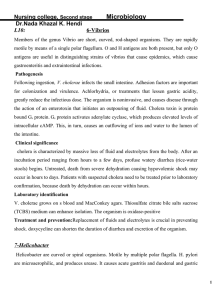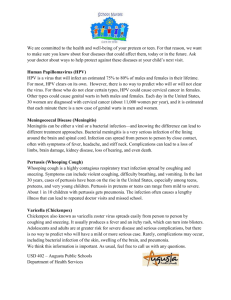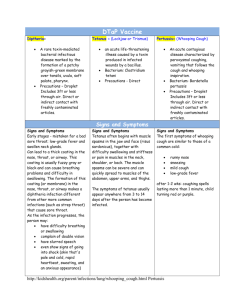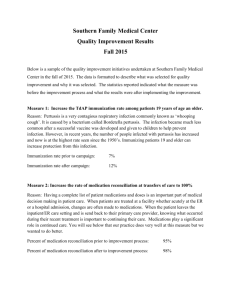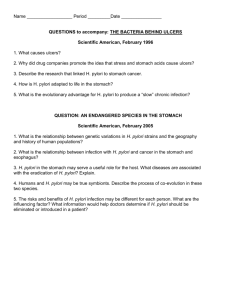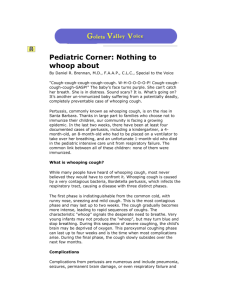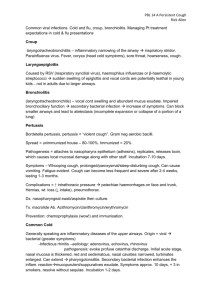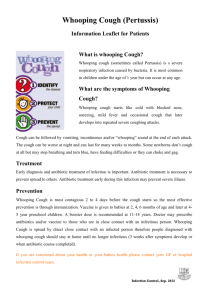Microbiology Nursing college, Dr.Nada Khazal K. Hendi
advertisement
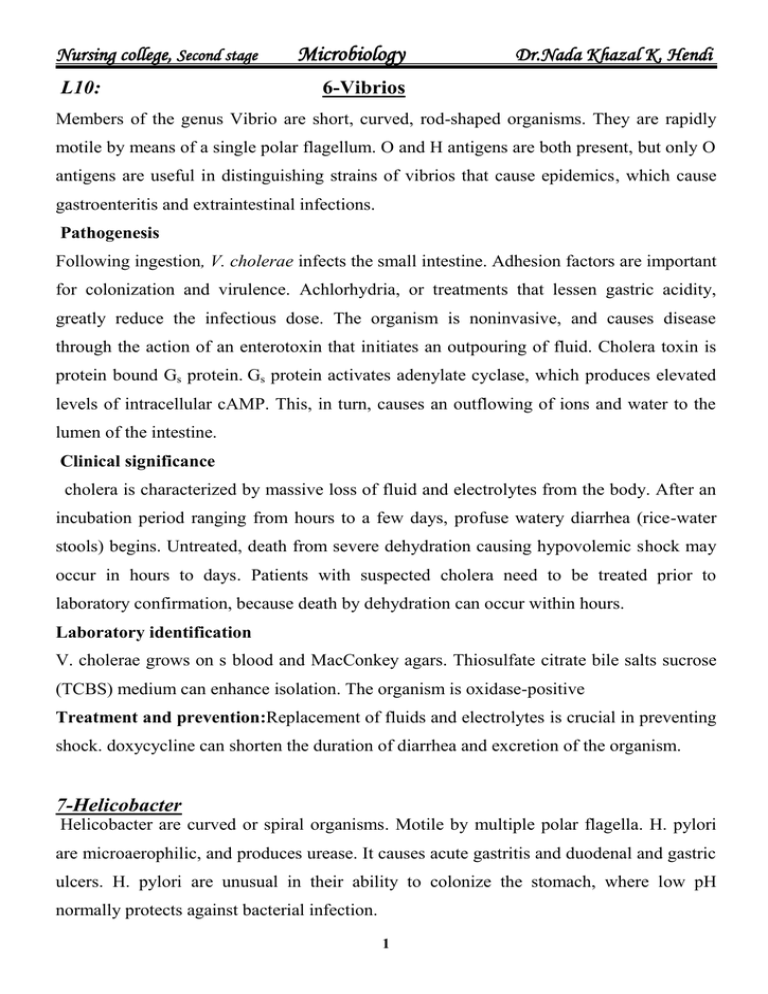
Nursing college, Second stage L10: Microbiology Dr.Nada Khazal K. Hendi 6-Vibrios Members of the genus Vibrio are short, curved, rod-shaped organisms. They are rapidly motile by means of a single polar flagellum. O and H antigens are both present, but only O antigens are useful in distinguishing strains of vibrios that cause epidemics, which cause gastroenteritis and extraintestinal infections. Pathogenesis Following ingestion, V. cholerae infects the small intestine. Adhesion factors are important for colonization and virulence. Achlorhydria, or treatments that lessen gastric acidity, greatly reduce the infectious dose. The organism is noninvasive, and causes disease through the action of an enterotoxin that initiates an outpouring of fluid. Cholera toxin is protein bound Gs protein. Gs protein activates adenylate cyclase, which produces elevated levels of intracellular cAMP. This, in turn, causes an outflowing of ions and water to the lumen of the intestine. Clinical significance cholera is characterized by massive loss of fluid and electrolytes from the body. After an incubation period ranging from hours to a few days, profuse watery diarrhea (rice-water stools) begins. Untreated, death from severe dehydration causing hypovolemic shock may occur in hours to days. Patients with suspected cholera need to be treated prior to laboratory confirmation, because death by dehydration can occur within hours. Laboratory identification V. cholerae grows on s blood and MacConkey agars. Thiosulfate citrate bile salts sucrose (TCBS) medium can enhance isolation. The organism is oxidase-positive Treatment and prevention:Replacement of fluids and electrolytes is crucial in preventing shock. doxycycline can shorten the duration of diarrhea and excretion of the organism. 7-Helicobacter Helicobacter are curved or spiral organisms. Motile by multiple polar flagella. H. pylori are microaerophilic, and produces urease. It causes acute gastritis and duodenal and gastric ulcers. H. pylori are unusual in their ability to colonize the stomach, where low pH normally protects against bacterial infection. 1 Nursing college, Second stage Microbiology Dr.Nada Khazal K. Hendi Pathogenesis & Clinical significance Transmission of H. pylori is thought to be from person to person; the organism has not been isolated from food or water. Untreated, infections tend to be chronic, even lifelong. H. pylori colonize gastric mucosal (epithelial) cells in the stomach, and duodenum or esophagus only. The organism survives in the mucous layer that coats the epithelium, and causes chronic inflammation of the mucosa. The organism is non-invasive. Initial infection with H. pylori causes acute gastritis. Urease released by H. pylori produces ammonia ions that neutralize stomach acid in the vicinity of the organism, favoring bacterial multiplication. Laboratory identification Noninvasive diagnostic tests include serologic tests (ELISA for serum antibodies to H. pylori).Invasive tests involve gastric biopsy specimens obtained by endoscopy. H. pylori can be detected in such specimens histologically, by culture, or by a test for urease. 8-Neisseria Gram– cocci in pairs (diplococci), catlase and oxidase positive, non motile, non hemolytic. The genus contains at least 30 spp. Two important spp are pathogenic for human; N. gonorrhoeae (gonococcus), Diplococci in kidney shape and N. meningitidis (meningococcus), Diplococci in spherical shape, encapsulated. A- N. gonorrhoeae (gonococcus) Transmission N. gonorrhoeae causes gonorrhoea only in human. It is transmitted in horizontal by sexually from person to person. Pathogenesis and clinical finding Venereal disease (VD) 1. Genital: In male are characterized by urethritis with yellow and creamy pus (purulent discharge) and painful urination with accompanied by dysuria, sometime leading to urethral stricture and infertility. 2 Nursing college, Second stage Microbiology Dr.Nada Khazal K. Hendi In female, the primary infection is in endocervix and extends to urethra and vagina, causing a purulent vaginal discharge and cervicitis. It may then progress to causing salpingitis, which can result in sterility or ectopic pregnancy. 2. Extra genital Proctitis (infection of rectum), stomatitis, infection of conjunctiva of newborn (ophthalmia nenatorum) is acquired from infected birth canal of mother. To prevent the infection instillation of tetracycline or erythromycin into conjunctiva sac of newborn. Lab Diagnosis - Microscopic: gram- stain smear of pus reveal many intracellular diplococci. - Cultured on Thayer-Martin medium, incubated under 5-10% CO2. - Serologic test: ELISA, CFT. Control Antibiotics: penicillin G, sulfonamide, ciprofloxacin. No effective vaccine is available. B- N. meningitidis (meningococcus) Transmission: the natural reservoir is human and transmitted by airborne droplets to other person. Pathogencity and clinical feature The humans are natural host in nasopharynx and causes disease only in human. the nasopharynx is portal entry. The organisms attach to epithelial cells of nasopharynx aid of pili, may be enter the bloodstream and spread to specific sites such as meninges, joints, disseminated through the body or it spread may be through sheath of olfactory nerve to meninges. The symptoms of meningococcal meningitis are fever, headache, stiff ne and increased level of PMNs in CSF. Lab Diagnosis - Microscopic: gram- stain smear of pus reveal many intracellular diplococci in PMN. - Cultured on Thayer-Martin medium,& chocolate agar incubated under5-10% CO2. - Serologic test: latex agglutination test. 3 Nursing college, Second stage Microbiology Dr.Nada Khazal K. Hendi Control Antibiotics: penicillin G, sulfonamide, ciprofloxacin. Immunization Vaccines are used. 9-Bordetella B. pertussis and B. parapertussis are the human pathogens. The former causes the disease pertussis (whooping cough). Whooping cough is a highly contagious disease and a significant cause of morbidity and mortality worldwide. They are small, aerobic, encapsulated, coccobacilli that grow singly or in pairs. Pathogenesis &. Clinical significance Transmission of Bordetella is via droplets spread by coughing, , disease is most common children (ages one to five). B. pertussis binds to ciliated epithelium in the upper respiratory tract. The bacteria produce of toxins and other virulence factors that interfere with ciliary activity, eventually causing death of these cells. The incubation period for pertussis ranges from 1 to 3 weeks. The disease can be divided into two phases: catarrhal and paroxysmal. Catarrhal phase: This phase nonspecific symptoms (rhinorrhea, mild conjunctival infection, mild fever, and then progresses to include a dry, nonproductive cough). Paroxysmal phase: With worsening of the cough, the paroxysmal phase begins. The term whooping cough derives from the paroxysms of coughing followed by inspires rapidly. Large amounts of mucus may be produced. Treatment & Prevention Erythromycin is the drug of choice for infections. Pertussis vaccine is available that has had a significant effect on lowering the incidence of whooping cough. It contains proteins purified from B. pertussis, and is formulated in combination with diphtheria and tetanus toxoids (DPT). To protect infants who are at greatest risk of life-threatening B. pertussis disease, immunization is generally initiated when the infant is two months old. 4 Nursing college, Second stage Microbiology 5 Dr.Nada Khazal K. Hendi
